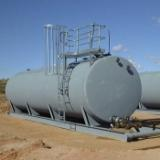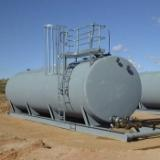Recognizing Diesel Fuel Algae
The last decade, since 2014 when the complete transition of all off-road diesel fuel to ULSD was completed, has seen a dramatic rise across the...

 For generators and diesel storage tanks fungus, mold, and bacteria pose a serious threat because they can clog fuel filters and decrease efficiency.
For generators and diesel storage tanks fungus, mold, and bacteria pose a serious threat because they can clog fuel filters and decrease efficiency.
The following procedures can be used to determine whether or not you have a fungus, mold, or bacteria problem with your diesel generators and diesel storage tanks. Also, what can be done to correct and prevent future problems.
There are three main problems with long term storage of diesel fuel. Most diesel fuel contains microbes that come in through the tank air vents or is in the fuel delivered to you. The key to preventing growth in the tanks is to keep the water out of the tank. Microbes live in the water and eat the diesel as a food source. The waste they excrete is what plugs up the fuel filters. What you will see in the filter is black and slimy.
Microbes need water to grow, and you have to remember that a drop of water is a lake to a microbe. If the fuel does have microbes, and you put it in a piece of equipment that has water in the tank, the microbes will grow in the equipment. The usual complaint is that the engine will not come up to RPMs or will just shut down, which is caused by fungus and mold plugging the fuel filter. Changing the fuel filter in most cases will allow the engine to restart.
Companies that exercise their generators on a regular basis, but do not load test them, may be in for a surprise. When you load a generator it will draw about three times the fuel it did at idle. It may idle ok but will shut down when under a load because of a microbe growth restriction in the fuel filters.
The second problem is caused by bacteria growing in the diesel fuel. The type of bacteria that grows in diesel fuel excretes an acid that will cause rusting of the diesel tank and damage to fuel system components. If you have noticed, I never mentioned the word algae because algae does not grow in diesel fuel. This is a term used by a lot of people but is incorrect because algae needs light to grow.
The third problem with diesel fuel in long term storage is the breakdown of the fuel. As diesel fuel ages it starts to form solids, which can have the same symptoms as the microbial growth described above, which blocks the fuel flow through the fuel filters. Fuel stabilizers are recommended for long term storage because stabilizers change fuel chemically so the fuel breaks down at a slower rate, extending its life.
If you are experiencing the symptoms or diesel generator problems I have explained above, the first step is do a microbe test. Microbe tests are done by taking a sample of fuel from the bottom of the tank. There are special test pads that are treated with sterile water and dipped into the diesel fuel sample. The sample is then placed in a sterile plastic incubation bag, placed in a dark place, and allowed to sit for five days. If the fuel is infected the microbes will grow on the sample. If you have a large number of generators we suggest spot testing a few of them. If the tests are positive we recommend treating all your generators to get them all to a base line where you know where you stand. The only way you will know this for sure is to treat all stored diesel storage fuel.
Treating a microbe infection requires a biocide that kills them on contact. It is important to note that you should not use products that say they inhibit microbial growth; you want a product that kills it. Tanks are always treated as if they were full so that the biocide is strong enough to kill microbes on the tank walls when they are refueled. You should use a product that stays active for at least thirty days in case there is a length of time between treating and refilling the tank. How the biocide is added is determined so that it results in a thorough mix of biocide and diesel fuel. Aerating the fuel and biocide is a good method of mixing.
You must remember that the diesel fuel you are using today is not the same as the fuel used ten years ago. We now have ultra low sulfur diesel which is more susceptible to microbial growth. Sulfur was a natural biocide that inhibited the growth of microbes. They went from 500 parts per million sulfur to 15 parts per million sulfur. Sulfur is also a lubricant that older engines need to lubricate seals and injectors.
A good case study is the program we put together for the City of Orlando. We spot tested generators and diesel storage tanks and found a number of fuel tanks that were infected with fungus and mold. We contacted their on-site fuel company and worked out a schedule of treatments. The on-site fuel company started by treating all their storage tanks with a double shocking dose of biocide (Bellicide) and a double dose of fuel stabilizer. This was done at the same time the fuel was being added to their tanks to insure a thorough mix of the stabilizer and biocide into the fuel. It is not satisfactory to just pour it in on top of the fuel.
We then set up a preventive maintenance program with their on-site fuel company where they would add a normal dose of biocide and stabilizer every 90 days. A month after the first maintenance treatment we did a follow up microbe test to confirm that 90 days is the correct treatment schedule. The program was a success, and the City of Orlando does not have any fuel problems related to diesel fuel at this time!
Beware of dishonest fuel polishers who place black die in their fuel samples to make you believe you have a really bad tank of fuel. Usually a few inches off the bottom of the tank the fuel is clean and just needs to be treated. Water found on the bottom of the tank needs to be removed when it is found and small amounts of water can be chemically removed. If you have an inch or more it needs to be pumped out. No water is acceptable because if you have water you will most likely have microbe problems. It is wise to check storage tanks with a water detecting paste on a monthly basis to stay ahead of any microbe growth. Treatment programs may vary depending on how often tanks are refilled. It is far cheaper to prevent these problems than it is to fix them after the fact, which usually involves equipment failure and expensive down time.
The last decade, since 2014 when the complete transition of all off-road diesel fuel to ULSD was completed, has seen a dramatic rise across the...
When considering diesel fuel contamination by microbes, 'the devil is in the details'.
Figuring out that you have algae in your fuel is one thing. But getting rid of it and keeping it away is a whole other ball game. A game you've got...